The 30 Years War can be divided into five major phases:
- 1618-21 Bohemian Revolt
- 1621-24 Palatinate phase
- 1625-29 Danish intervention
- 1630-35 Swedish intervention
- 1636-48 French intervention
The following Timeline just lists the major battles. See Atkinson: Thirty Years War and Wikipedia: Thirty Years War for more details.
Background
The Map, from Wikipedia: Imperial Circle, shows the imperial circles in 1512. It is based in part on a map published in the “Historical Atlas” by Prof. William R Shepherd, pub. Henry Holt & Co. (New York, 1911)
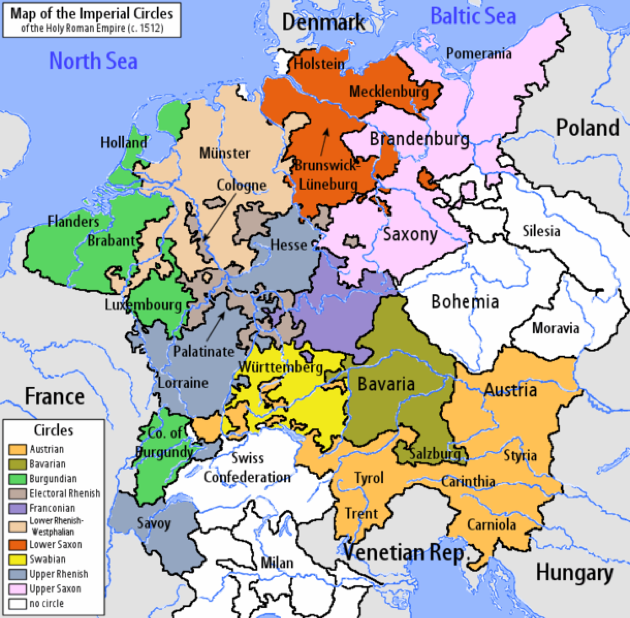
1618-21: Bohemian Revolt
In 1617 Ferdinand of Styria, was elected by the Bohemian Estates to become the Crown Prince of Bohemia and the heir to the throne (Wikipedia: Thirty Years War). In May 1618 Ferdinand sent two Catholic councillors (Vilem Slavata of Chlum and Jaroslav Borzita of Martinice) to Prague as his representatives. On 23 May 1618 a group of Bohemian Protestants seized the governors and threw them out of the palace window. Unexpectedly they survived unharmed. This event, known as the Second Defenestration of Prague, is what started the Bohemian Revolt. The conflict soon spread through all of Greater Bohemia (Bohemia, Silesia, Lusatia and Moravia), then Upper and Lower Austria. The Bohemians, desperate for allies against the Emperor, applied to be admitted into the Protestant Union led by the Calvinist Frederick V, Elector Palatine. The Bohemians hinted that Frederick would become King of Bohemia if he allowed them to join the Union and come under its protection. However, similar offers were made by other members of the Bohemian Estates to the Duke of Savoy, the Elector of Saxony, and the Prince of Transylvania. The Austrians, who seemed to have intercepted every letter leaving Prague, made these duplicities public. This unravelled much of the support for the Bohemians, particularly in the court of Saxony.
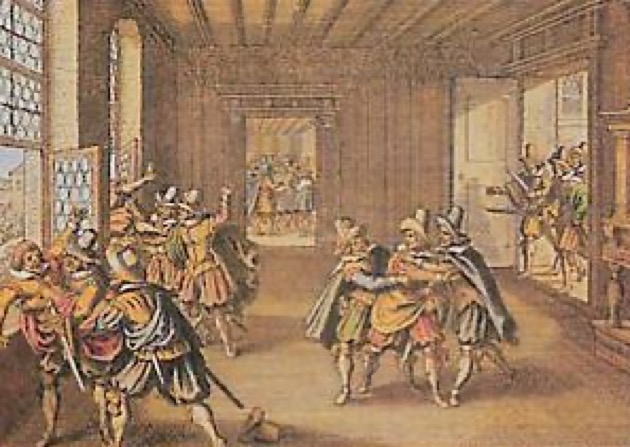
19 Sep – 21 Nov 1618: Siege or Battle of Pilsen (Plzeň) 

A Bohemian Protestant army under General von Mansfeld successfully besieged and assaulted the city of Pilsen in Bohemia (Wikipedia: Siege of Plzeň).

20 Mar 1619: Ferdinand becomes King of Bohemia
On 20 Mar 1619 Matthias died and Ferdinand automatically became the King of Bohemia (Wikipedia: Thirty Years War). Ferdinand was also subsequently elected Holy Roman Emperor as Ferdinand II.
10 Jun 1619: Battle of Sablat (Záblati) 

An Imperialist Army under Count Bucquoy defeated a Protestant Bohemian army led by Count Mansfeld (Wikipedia: Záblati). Mansfeld lost at least 1,500 infantry and his baggage train.
5 Aug 1619: Battle of Wisternitz (Věstonice) 

A Protestant Bohemian army defeated an Austrian army under Dampierre (Wikipedia: Dolní Věstonice).
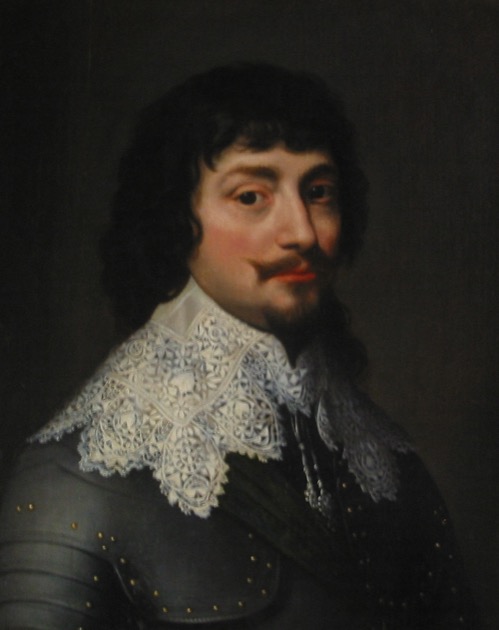
17 Aug 1619: Frederick V becomes King of Bohemia
The Bohemian rebels formally deposed Ferdinand as King of Bohemia and replace him with the Palatine Elector Frederick V (Wikipedia: Thirty Years War).
8 Nov 1620: Battle of White Mountain 


A Catholic army of 25,000 men including Imperialists under Buquoy and of the Catholic League under Count Tilly decisively defeated 21,000 Bohemians and mercenaries under Christian of Anhalt near Prague (Wikipedia: White Mountain). The Catholics had 18,500 infantry and 6,500 cavalry, and suffered 700 dead or wounded. Christian had 10,000 infantry and 11,000 cavalry, and lost 5,000 dead or wounded. In addition to becoming Catholic, Bohemia would remain in Habsburg hands for nearly three hundred years (Wikipedia: Thirty Years War).
1621-24: Palatinate Phase
With the defeat of the Bohemian revolt Frederick V lost his territories and was outlawed from the Holy Roman Empire (Wikipedia: Thirty Years War). His title of elector of the Palatinate was given to his distant cousin Duke Maximilian of Bavaria, and his lands in the Palatinate were given to Catholic nobles. Catholic League and Spanish forces began the subjugation of the Palatinate.
24 May 1621: Protestant Union dissolved
The Protestant Union was formed 14 May 1608 and dissolved 24 May 1621 (Wikipedia: Protestant Union).
27 Apr 1622: Battle of Wiesloch / Mingolsheim 

At the village of Mingolsheim a Protestant army under General von Mansfeld rebuffed a Catholic League army under Count Tilly. (Wikipedia: Wiesloch).
6 May 1622: Battle of Wimpfen 


A Catholic army including forces of the Catholic League under Marshal Tilly and Spanish troops from the Low Countries under Gonzalo de Córdoba defeated a Protestant army (Wikipedia: Wimpfen). Georg Friedrich, Margrave of Baden-Durlach, had only 14,000 men (mostly mercenaries) to face the approximately 25,000 Catholics.
20 June 1622: Battle of Höchst 


A Catholic army mauled a much smaller Protestant Union army under Christian of Brunswick as the Protestants crossed the Main river west of Frankfurt (Wikipedia: Battle of Höchst). The approximately 25,000 Catholics comprised forces of the Catholic League under Marshal Tilly and Spanish troops from the Low Countries under Gonzalo de Córdoba. Brunswick managed to cross the river but lost 2,000 of his 12,000 men and most of his baggage.
29 Aug 1622: Battle of Fleurus 

A Spanish army under Gonzalo de Córdoba defeated a German Protestant mercenary army headed for Dutch service in the Low countries (Wikipedia: Fleurus). Wikipedia: Fleurus has a comprehensive Order of Battle and deployment for both armies. Córdoba had the smaller army, with only 8,000 against the 14,000 in the German army. Córdoba had 5,200 infantry in the centre deployed in four composite squadrons. The 2,000 cavalry were deployed on the wings. Gauchier, on the right, had five cavalry squadrons plus 800 commanded musketeers deployed in woods. De Sylva had four cavalry squadrons on the left. About half of the Spanish infantry were veterans. The majority of the cavalry were Walloon recruits. Amongst the cavalry there were four veteran cuirassier companies, 25 newly raised cuirassier companies, and 23 newly raised arquebusier companies. The Spanish had 4 guns. The Protestants were under von Mansfeld and Christian of Brunswick. Mansfeld had 8,000 infantry in the centre formed into eight composite battalions and deployed in a checker board of two lines. The 6,000 cavalry were on the wings, 10 companies on the right under Streiff and 50 companies on the left under Brunswick. The Protestants had 11 guns. The Protestant infantry were poor quality but the cavalry were good quality and predominantly cuirassiers. Córdoba had assumed a blocking position north of the town of Mellet, near Fleurus. Being much weaker in cavalry he secured his flanks with woods. After a short bombardment the Protestant commanders launched a general assault in an attempt to break through the Spanish position. The poorly trained German infantry in the centre became disordered as they advanced, inviting the Spanish left flank cavalry to attack. The opposing German cavalry drove the Walloons off, but had no luck against the Spanish infantry. The massed troopers on the German left drove the Spanish right flank cavalry back on the second attempt and attacked the Tercio of Naples (the best unit in the Spanish array). The German infantry failed to close and the Spanish veterans held their ground, and assisted by the musketeers in the woods, wounded Brunwick and drove off his troopers. After five hours of fighting Mansfeld conceded the field. The Protestants lost 5,000 dead, wounded, or captured, compared to the Spanish 300 dead and 900 wounded. The following day the Spanish cavalry destroyed the remaining Protestant infantry as they marched. Of the 24,000 men that left the Palatine only 3,000 Protestant cavalry managed to reach the Dutch.
6 Aug 1623: Battle of Stadtlohn 

Count Tilly defeated a smaller Protestant army under Christian of Brunswick near Stadtlohn in Westphalia (Wikipedia: Stadtlohn). Tilly’s approximately 25,000 men caught Brunswick’s 15,000 recently raised troops as they retreated towards the United Provinces. Brunswick deployed on a hill from where they saw off several attacks. Eventually the Catholics broke the Protestant’s cavalry flanks. Brunswick’s infantry then tried to flee, but were prevented by a bog to their rear. Brunswick lost 6,000 killed, 4,000 captured, and presumably 2,000 deserters and all of his artillery and ammunition. Only Christian and 2,000 cavalrymen escaped.
1624
In 1624 England, France, the United Provinces of the Netherlands, Sweden, Denmark, Savoy, Venice, and Brandenburg formed an anti-Hapsburg alliance to fight against Spain and the Holy Roman Emperor (Wikipedia: Stadtlohn).
1625-29: Danish intervention
Christian IV of Denmark had a strong interest in the events in Germany (Wikipedia: Thirty Years War). He was Lutheran so supported the Lutheran rulers of Lower Saxony. But he also had land in German. He was Duke of Holstein and the ruler of Hamburg (from 1621), and his second son was made bishop of Bremen. As a result Christian had himself appointed war leader of the Lower Saxon Circle and by 1625 had raised an army of 20,000-35,000 mercenaries, partly funded by France and England. The Protestants were suddenly infused with fresh hope as Denmark became the first major European nation to formally enter the war (Wikipedia: Dessau Bridge). With the new alliance came ambitious plans involving Christian of Brunswick to attack the forces of Tilly in the Rhineland, and for Mansfeld to challenge Wallenstein in the Archbishopric of Magdeburg.
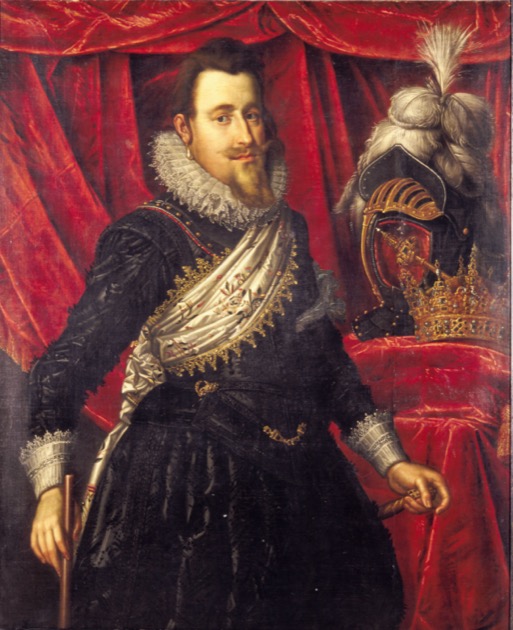
25 Apr 1626: Battle of the Dessau Bridge 

General Wallenstein defeated Count Mansfeld (Wikipedia: Dessau Bridge). Wallenstein had 20,000 men to Mansfeld’s 12,000, although initially Mansfeld was under the impression he had more men. Because of this misconception Mansfeld attacked across the bridge over the Elbe river. He realised his mistake as the Catholic masses were brought to bear. Trapped against the river Mansfeld lost 4,000 dead, wounded, or captured.
27 Aug 1626: Battle of Lutter-am-Bamberg 

A Catholic League army under Count Tilly defeated the forces of Christian IV of Denmark at Lutter am Barenberge in the Imperial Circle Estate of Lower Saxony (Wikipedia: Lutter am Barenberge). Both armies had 20,000 men. On three occasions the imperial infantry broke through the Danish line only to be repulsed by a cavalry counter-attack. However when the Catholics captured the entire Danish artillery the Danes paniced and retreated towards the town of Stade. The Danish losses were approximately 4,000 dead, 2,000 wounded, and 2,500 prisoners.
5 Jul – Oct 1628: Siege of Stralsund 

The Imperialist General Wallenstein failed to take the port of Stralsund (Wikipedia: Stralsund). Wallenstein swore to take the port in three days, but never did, withdrawing after an 11 week siege. The port was defended mainly by the inhabitants, aided by a small garrison of Swedes and Scots.
12 Aug 1628: Battle of Wolgast 

Imperialists under Wallenstein defeated the army of Christian IV of Denmark at Wolgast, Germany (Wikipedia: Wolgast).
1629: Treaty of Lübeck
In the Treaty of Lübeck Christian IV retained Denmark but had to stop his support for the Protestant German states (Wikipedia: Thirty Years War). This gave the Catholic powers the opportunity to take more Protestant land during the next two years.
1630-35: Swedish intervention
Gustavus Adolphus (Gustav Adolf), King of Sweden, was the next foreign ruler to come to the aid of the German Lutherans and to seek political and financial advantage in Germany (Wikipedia: Thirty Years War). Both France and the Dutch sent subsidies. In 1630 Gustav landed 13,000 men at Peenemünde (Wikipedia: 1st Breitenfeld). From 1630 to 1634, Swedish-led armies drove the Catholics back, regaining much of the lost Protestant territory.
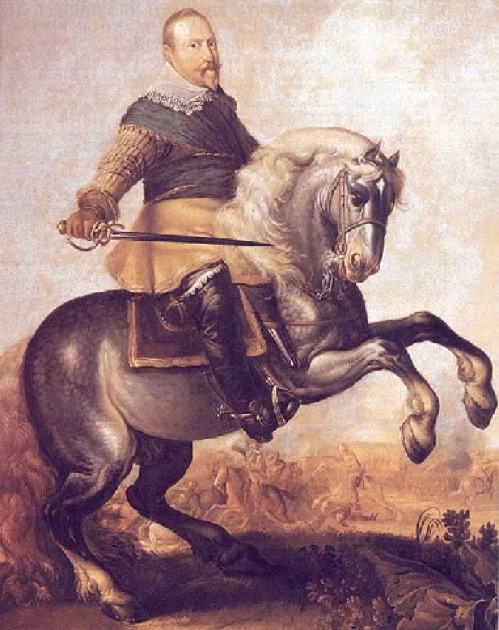
Nov 1630 – 20 May 1631: Siege and Sack of Magdeburg 

Imperialist forces besieged Magdeburg from Nov 1630 until 20 May 1631 (Wikipedia: Magdeburg). When the city fell the Imperial soldiers rapidly went out of control and started to massacre the inhabitants and set fire to the city in twelve different locations. Of the 30,000 citizens, only 5,000 survived. For fourteen days, charred bodies were carried to the Elbe River to be dumped to prevent plague. The devastation was so heavy that the several news expressions entered common parlance:
- “magdeburgization” – a a term signifying total destruction, rape and pillaging.
- “Magdeburg justice”, “Magdeburg mercy” and “Magdeburg quarter”, all of which basically meant no quarter specifically as it applied to Catholic prisoners of Protestant forces.
22 Jul 1631: Battle of Werben 

16,000 entrenched Swedes under Gustavus Adolphus drove off 23,000 Imperialists under Count Tilly (Wikipedia: Werben). The Swedish batteries and the cavalry under Wolf Heinrich von Baudissin were the main contributors to victory. The Imperialists tried again a few days later and won; the Swedes lost 6,000 men.
17 Sep 1631: First Battle of Breitenfeld 

The Swedes under Gustavus Adolphus defeated a Catholic League army under Tilly at the crossroads village of Breitenfeld 6 km north of the walled city of Leipzig (Wikipedia: 1st Breitenfeld).
Tilly got the battlefield first (Wikipedia: 1st Breitenfeld). He deployed his left flank near Breitenfeld and his right by Seehausen. The Catholics had 14 infantry squadrons of about 1,500 men. These squadrons had a front of 150 men and a depth of 10 men, with a centre of pikemen and musketeers on each flank. One of these infantry squadrons was attached to each wing along with the cavalry. The other 12 infantry squadrons comprised the centre of the army and were grouped into sets of three squadrons. The centre squadron in each set was slightly ahead of the other two. Pappenheim commanded the cavalry on the left and Fürstenburg those on the right. Tilly had no reserves except for some cavalry placed behind his infantry.
The Swedish army had 24,000 men and their Saxon allies had 18,000 under the Elector John George I (Wikipedia: 1st Breitenfeld). The allied armies deployed separately with the Swedes on the right and the Saxons to their left. Both Gustav and John George had cavalry on their wings, so the allied army had cavalry in the centre. The Saxon infantry deployed conventionally but the Swedes adopted two long thin lines. Each infantry unit was five men deep for pikemen, and six men deep for musketeers. Then shallow depths allowed Gustav to free up troops for a reserve.
The artillery of each side began firing about midday and the Swedes quickly got the better of the exchange (Wikipedia: 1st Breitenfeld). After a couple of hours Count Pappenheim charged with the left flank Catholic cuirassiers. Swedish musketry repulsed the Germans seven times. The Swedish reserve cavalry then counter charged the Imperial cavalry and drove them off towards Halle. The Swedish cavalry pursued until recalled by Gustav.
The right flank Catholic cavalry charged and routed the Saxon cavalry, who fled towards Eilenburg (Wikipedia: 1st Breitenfeld). Tilly consequently sent the majority of his infantry in an oblique march diagonally across his front to attack the remaining Saxons. The entire Saxon army fled the field, stopping only briefly to loot the Swedish camp.
As Tilly reorganised his men to attack the Swedish flank, Gustav redeployed his second line at right angles to the front to face the threat (Wikipedia: 1st Breitenfeld). Meanwhile the Finnish Hakkapeliittas attacked across the former front and captured the Imperial artillery. These guns were then repositioned to play upon the left flank of the Catholic line. The massed fire power of the Swedish and captured guns soon broke the Imperial troops. Tilly was injured in ensuing retreat.
Losses were (Wikipedia: 1st Breitenfeld):
- Catholics: 7,600 dead, 6,000 captured, 12,400 deserted, 3000 wounded.
- Swedes: 3,500 dead/wounded,
- Saxons: 2,000 dead
Tilly only had 6,000 men left (Wikipedia: 1st Breitenfeld). In contrast Gustav made up his losses by recruiting prisoners and ended up with more men than he started with.
15 Apr 1632 Battle of Rain / Battle of the River Lech 

40,000 Swedish troops under Gustavus Adolphus defeated 25,000 Catholic League troops under Count Tilly near the city of Rain (Wikipedia: Rain). Tilly had his men entrenched on a hill beyond the River Lech. Gustav hoped to catch the entire Catholic army by launching a strong feint attack across the River Lech directly against the Germans; this attack was supposed to allow his cavalry to cross the river unnoticed 10 km south of the imperial left wing. As it happens, once Tilly was wounded, the flanking manoeuvre wasn’t necessary and the Catholic army crumbled in the face of the frontal attack . Operations commenced the night prior with the Swedes building a bridge of boats across the Lech river. In the morning 300 Finnish Hackapelite troops crossed the river in the face of German fire. The Hackapelites dug earthworks for batteries which then protected the rest of the Swedish’ army as they crossed the river. With his army across the river, Gustavus immediately stormed the hill. Tilly and his second in command (Aldringen) were both wounded early in the battle – Tilly subsequently died – leaving the army leaderless. As a result Maximilian I, Elector of Bavaria, ordered a retreat before the Swedish cavalry arrived. The Catholics abandoned their baggage and artillery on the field. A storm and high winds that night blocked the roads and prevented a Swedish pursuit. The Imperial forces lost 3,000 men and the Swedes 2,000.
Late Summer 1632 Battle of the Alte Veste 

With Gustavus Adolphus triumphant in Germany Ferdinand II recalled Wallenstein into military service (Wikipedia: Battle_of_Allte Veste). Wallenstein raised a new army and in late summer moved to threaten the Swedes at Nürnberg by creating a fortified camp nearby. Gustavus Adolphus repeatedly, and unsuccessfully, tried to entice Wallenstein into open battle. With supplies dwindling the Swedes attacked the Imperial camp at the Alte Veste (Old Fortress). This was a derelict castle on a wooded hill that dominated the Imperial camp. When the Swedish infantry failed against the enemy trenches and abatis, the cavalry were sent in dismounted. Wallenstein saw his opportunity, sallied his cavalry and cut down many of the exhausted Swedes. The Swedish cavalry reserve prevented a complete disaster, but it was a clear Imperial victory. Lennart Torstenson, the Swedish artillery commander, was taken prisoner. Gustav Adolf received reinforcements days later and Wallenstein left camp and moved north.
3-4 Sep 1632 Battle of Fürth 

Wallenstein and Maximilian joined forces on 11 Jul 1632 forcing Gustav to retreat to Fürth on the outskirts of Nuremberg (Wedgwood, 1992). The allies followed and built a strong encampment on a long ridge overlooking the river Rednitz near Gustav’s position. Being numerically weaker Gustav summoned his forces from all over Germany. Thus began a battle of attrition. The Swedes and Bavarians suffered from lack of food and fresh water, but Wallenstein’s men did not. The Swedish reinforcements arrived 16 Aug and on 3-4 Sep Gustav attacked the Catholic camp. The Swedish cavalry could not deploy in the rough shrub covered slopes so the infantry attacked alone. They were repulsed with heavy losses. On 18 Sep Gustav abandoned his position and headed south towards Austria. Wallenstein headed north towards Saxony.
16 Nov 1632 Battle of Lützen
Autumn 1632 – 33
In Autumn 1632 Marshal Horn led a large detachment of Swedish up the Rhine and occupied most of Alsace (Wedgwood, 1992). In Mar 1633 Horn joined up with a force under Bernard of Sae-Weimar at Oberndorf in the Black Forest. They turned their attentions to Bavaria. The Bavarians under Aldringer retreated into Munich, although many men surrendered to the Swedes. Horn’s first target was the fortress city of Breisach on the upper Rhine. Maximilian unsuccessfully appealed to Wallenstein for assistance; Wallenstein was actually engaged in peace talks with his opposite number Arnim and sent no aid. The Bavarians were more successful with the Spanish. In May the Spanish agreed to shoulder the expenses of the war and the Cardinal-Infant had an army ready to cross the Alps. In July the Swedish closed around Breisach. Wallenstein then launched into action, but only to send Holk into Saxony where in August Holk died and his army disintegrated due to rain and disease. In September Wallenstein again engaged Arnim in peace talks, which came to nothing. By then the Spanish advance guard (under the Duke of Feria) was at Innsbruck on its way to Breisach. Wallenstein had been preventing Aldringer joining the Spanish but the latter disobeyed orders and met Feria at Schongau. (stopped at p 351)…
6 Sep 1634 Battle of Nördlingen 



This is a summary only. For the full story have a look at Picouet: The Battle of Nordlingen.
A Catholic army comprising Imperialist and Spanish troops decisively defeated the Protestant army of Sweden and Saxony (Picouet: The Battle of Nordlingen; Wikipedia: Nördlingen). The Protestants were trying to break the Catholic siege of Nrdlingen. Ferdinand of Hungary, the future Holy Roman Emperor, commanded the Imperialists and his cousin the Cardinal-Infante Ferdinand led the Spanish. The Catholics had 23,000 infantry, 13,000 cavalry and 32 guns. The Spanish contingent comprised 18,000 men, including 13,500 infantry; of the latter 3,100 were actual Spanish nationals. The Spanish included reinforcements under the Count of Cervellón or Serbelloni (joined 26 Aug 1634). The Protestants were unaware of the Spanish reinforcements so expected their enemies to have only 7,000 infantry. The Protestant commanders were Duke Bernhard of Saxe-Weimar (Saxons) and Gustav Horn (Swedes). The Protestants had 16,300 infantry, 9,300 cavalry and 62 guns. Operations began at 1400 hours on 5 Sep 1634 when the Protestant vanguard encountered the Catholic piquets. Skirmishing began at 1500 hours near Lachberg’s hill as the Protestants tried to drive off the Spanish dragons and imperial Croats . The Catholics began a delaying action to allow the main body to deploy near Albuch hill. An additional 3,000 Catholic cavalry joined the fray and it took the Protestants until 1800 hours to capture Lachberg’s hill. The Protestants reached the next obstacle, Haselberg hill, at 2100 hours. This was defended by a Spanish force of 600 musketeers (three mangas) and 200 dragoons, subsequently reinforced by an addition 400 musketeers. It took the Protestants another four hours convince the Spanish to withdraw. By this time the Catholics were deployed, and had six infantry regiments/tercios dug in on Albuch hill. The battle began at 0500 hours on 6 Sep 1634. The mercenaries of the Swedish Blue, Black and Yellow Horn regiments repeatedly threw themselves against the defences on Albuch hill but without lasting success, largely thanks to the Old Tercios (Tercios Viejos) of Fuenclara, Idiáquez, and Toralto,. The Imperial and Saxon forces were largely observers of this engagement. Ferdinand of Hungary launched his men into attack, however, when Saxe-Weimar depleted the Saxon line by sending two of his three infantry brigades to reinforce his Swedish allies. The Saxons quickly broke and the Swedes soon followed suit when they saw their line of retreat being blocked. The Protestant survivors fled to Heilbronn and Horn was captured in the pursuit.
Protestant Losses: 12,000 – 18,000 killed, wounded, deserted or prisoner
Catholic Losses: 3,500 men (1,500+ for the Spanish Army)
The battle marked the end of the Swedish attempts to dominate Germany (Wikipedia: Nördlingen). Most of the German Protestant princes sought peace with the Emperor (the 1635 Treaty of Prague) but France entered the war to combat Spain’s ambitions.
30 May 1635 Peace of Prague and Demise of the Catholic League
The Catholic League ceased to exist with the Peace of Prague of 30 May 1635 (Wikipedia: Catholic League (German)).

4 Oct 1636 Battle of Wittstock 


A Swedish army under Baner defeated a combined Imperialists (under von Hatzfeldt) and Saxons
(under John George I) in the hills and forests south of Wittstock in north Germany (Wikipedia: Wittstock).
Baner had only 16,000 men to the enemies 22,000. For 11 days Baner had been trying to gain a
tactical advantage over his larger enemy, and on 4 Oct 1636 Banér’s army intercepted their
opponents. The Imperials formed up a range of sandy hills called the Scharfenberg. They
strengthened their front with six ditches and a wall of linked wagons. Baner, however, elected not
to attack over the open fields in front of the enemy position, and instead attacked the
Imperialist left flank. The Imperials were forced to redeploy to meet the new threat … The
Swedes lost only 3,100 dead or wounded but inflicted 7,000 killed and a further 2,000 prisoners
who were subsequently recruited into the Swedish army.
1636-48: French intervention
Catholic France now pitched in on the side of the Protestants, specifically the Dutch and the Swedes (Wikipedia: Thirty Years War). This was as a direct result of on-going competition between France and the Hapsburgs in Spain and the Holy Roman Empire. Spain, in retaliation, invaded French territory.
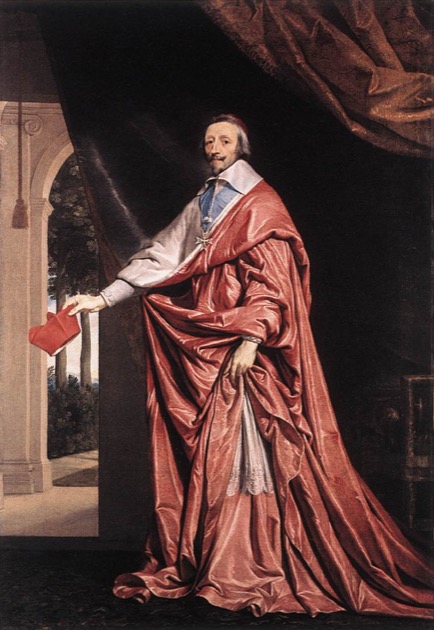
10 Oct 1637: Fall of Breda
Feb 1638: Battle of Rheinfelden
26 May 1642: Battle of Honnecourt
Wikipedia: Battle of honnecourt
23 Oct 1642: 2nd Battle of Breitenfeld
19 May 1643: Battle of Rocroi
24 Nov 1643: Battle of Tuttlingen
3, 5, and 9 Aug 1644: Battle of Freiburg
Three day battle.
Nov 1644: Battle of Jüterbog
24 Feb 1645: Battle of Jankov 

The Swedes under Field Marshal Torstensson decisively defeated the Imperialists under General von Hatzfeldt at Jankov (Jankau) in southern Bohemia (~50 km SSE of Prague) (Wikipedia: Jankov). The Swedes had 6,000 infantry, 9,000 cavalry, and 80 guns to the Imperialists 5,000 infantry, 10,000 cavalry and 26 guns. The Swedes suffered 1,500 dead, wounded or missing, and inflicted 8,500-9000 dead, wounded or captured on their enemy. Hatzfeldt was captured.
2 May 1645: Battle of Mergentheim
3 Aug 1645: Battle of 2nd Nördlingen
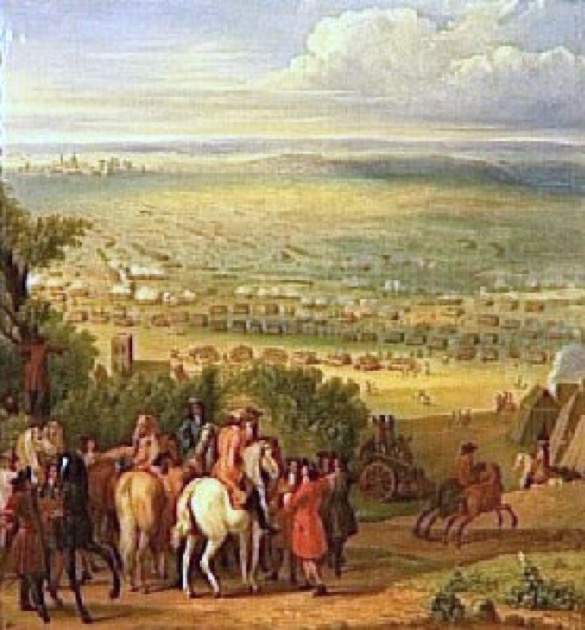
20 Aug 1648: Battle of Lens 

In the last major battle of the war a French army under Louis II de Bourbon, Prince de Condé, defeated a Spanish army under Archduke Leopold (Wikipedia: Lens). The French had captured Lens, a fortified city in the Spanish Netherlands, in 1647. A year later the French government was distracted by the Fronde (a rebellion), and the Spanish saw an opportunity to retake the city. The Prince de Condé rushed from Catalonia to Flanders and cobbled together an army of 16,000 men and 18 guns (including a Swedish contingent) to face the Archduke’s 18,000 men and 38 guns. Cavalry dominated both armies, with more than half the troops being horse. The Spanish deployed on high ground so Condé decided to withdraw. This encouraged the Spanish cavalry to skirmish with the French rear guard. The fighting escalated into a fully fledge battle. The Spanish infantry under Nelson Antonio Fernandez III drove their French counterparts back, breaking the Gardes Françaises regiment. However, on French cavalry routed the Spanish horse and enveloped the Spanish centre. The French lost 3.500 casualties, but inflicted 3,000 dead or wounded and took 5,000 prisoners.
7 May 1648: Battle of Zusmarshausen

1648: Siege and Battle of Prague, and Battle of the Charles Bridge 

In the finale of the siege of Prague the Swedish army under General Hans Christoff von
Königsmarck stealthily entered the city and captured Prague Castle on the western bank of the
Vltava river (Wikipedia:
Prague (1648)). When Swedes tried to cross the Vltava river into the Old Town on the eastern
bank, the city residents stopped them in bitter fighting on the Charles Bridge. The Swedes settled
for looting the Castle.
Post War
The is the map of Europe 1648 at the end of the war. It is from Wikipedia: Thirty Years War but based on the Penguin Atlas of Modern History.
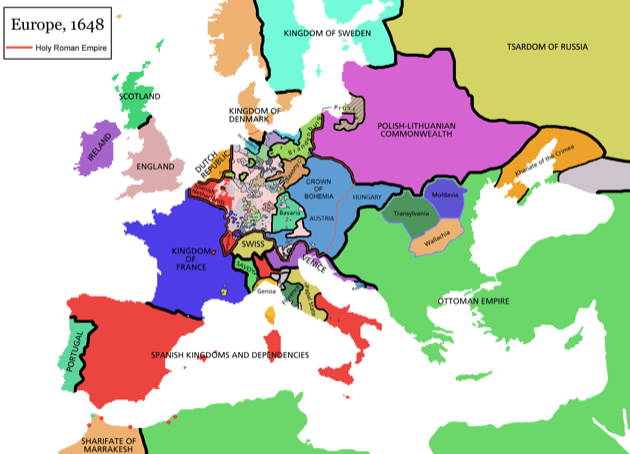
References
Father Tilly – Thirty Years War Rules
Gush, G. (1975). Renaissance Armies 1480-1650. Patrick Stephens.
Early Modern Warfare Society (Curt Johnson) including:
- EMW: The French Army of the Thirty Years’ War: Introduction and Maison du Roi
- EMW: The French Army of the Thirty Years’ War: Line Infantry
Picouet: The Spanish Tercios from 1525 to 1704
has some great material on the Tercios including a description of the several battles (e.g. Picouet: The Battle of Nordlingen)
Parker, G. (1979). Europe in Crisis 1598-1648. Fontana Paperbacks.
Wedgwood, C. V. (1992). The Thirty Years War. Pimlico.
Wikipedia contains a mass of material, but all the related pages are subordinate to this one.


Do you know about the Swedish Commander Johan Printz surrendering the town of Chimnitz? He was disgraced and s nt back to Sweden, later to be made governor of New Sweden. I can find a lot about his activities as governor but little about him as a commander in the Thirty Year’s War. Thanks for any info or references you may have.